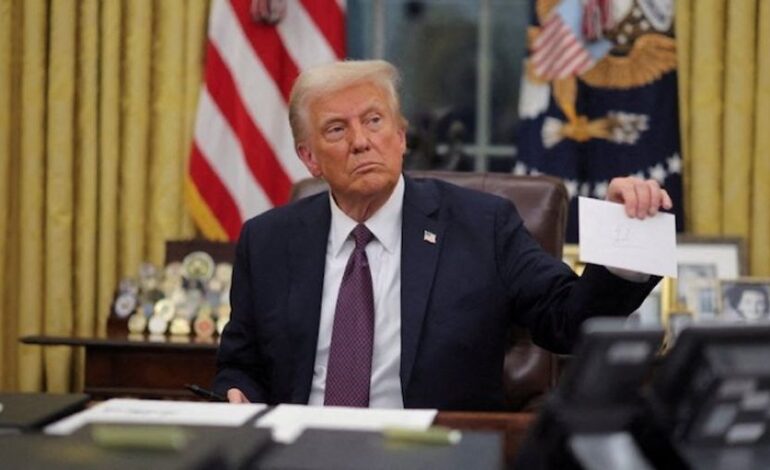Four U.S. Presidents Attempt Tough Immigration Policies, Few Results

U.S. immigration policy has seen a series of aggressive approaches from four presidents over the past two decades, yet the undocumented population has remained stubbornly static at around 11 million. Despite various tactics—ranging from deportation raids to executive orders—significant reductions have not materialized, raising questions about the effectiveness of these methods in addressing immigration challenges.
Historical Context of Immigration Enforcement
All modern U.S. presidents, both Republican and Democratic, have grappled with the complexities of undocumented immigration. Starting with President George W. Bush, who initiated workplace raids in 2006, the strategy aimed to increase deportations. A notable instance was a massive raid at a meat processing plant in Postville, Iowa, in 2008, where 900 agents arrested 398 employees, predominantly Latino. Following these arrests, many were charged with serious crimes, and nearly 300 received prison sentences before deportation.
Bush also launched the Secure Communities program, which focused on deporting noncitizens arrested for any crimes. During his presidency, approximately 2 million immigrants were deported. His successor, President Barack Obama, continued this trend but adjusted the focus to prioritize noncitizens convicted of felonies. In the fiscal year 2013 alone, Obama’s administration deported a record 400,000 individuals, earning him the title of “Deporter in Chief” among critics. Despite these efforts, the overall size of the undocumented population saw little decline.
Obama’s approach included the introduction of the Deferred Action for Childhood Arrivals (DACA) program in 2012, which provided relief and work authorization for more than 500,000 undocumented immigrants who entered the U.S. as children. By the end of his tenure, approximately 3 million individuals had been deported, yet the undocumented population remained largely unchanged.
Trump’s Unconventional Tactics and Biden’s Response
When President Donald Trump took office, he implemented a markedly different approach to immigration enforcement. His administration began with controversial policies such as the “Muslim ban,” which restricted entry from predominantly Muslim countries. Trump’s tenure saw an expansion of immigration operations, including raids at courthouses, which had previously been considered safe spaces.
In 2019, Trump introduced the Remain in Mexico policy, requiring asylum seekers to wait in Mexico while their claims were processed. Additionally, he invoked Title 42 in 2020 to halt legal immigration during the COVID-19 pandemic. While the Trump administration succeeded in decreasing legal immigration numbers, there was no substantial evidence that these policies reduced the overall undocumented population.
Following Trump, President Joe Biden aimed to adjust some of the harsh measures instituted by his predecessor. His administration slowed the construction of the border wall and ceased workplace raids in 2021. However, Biden’s response to surges in migration included temporarily closing ports of entry and increasing arrests. His administration faced criticism from immigrant rights groups when incidents of armed Border Patrol officers confronting Haitian migrants were captured on video.
As of 2022, the undocumented population remained at approximately 11 million, indicating ongoing challenges in effectively managing immigration.
Trump’s second term began with renewed efforts to implement a mass deportation campaign through executive orders, which were unprecedented in their scope. In January 2025, he announced an expedited removal process that would apply to any noncitizen apprehended anywhere in the U.S., deviating from previous practices that focused on border regions. Trump also sought to deport Venezuelan nationals affiliated with the Tren de Aragua gang, invoking the Alien Enemies Act of 1798.
In June 2025, declaring an “invasion” of migrants, Trump deployed military support in Los Angeles for immigration enforcement. He also attempted to alter birthright citizenship through an executive order, which has sparked legal challenges and is expected to be reviewed by the Supreme Court.
Under Trump’s second administration, while immigration arrests surged—with ICE recording the highest monthly arrests in five years at around 30,000—the actual deportation numbers have not kept pace. Approximately 18,000 deportations were recorded, falling short of the record-setting numbers achieved during Obama’s presidency.
The disconnect between arrests and deportations highlights the difficulties the Trump administration faces in fulfilling its ambitious deportation agenda. The underlying issues driving undocumented immigration, such as the search for work and safety from violence, remain unaddressed by successive administrations. Until a comprehensive solution is developed, the undocumented population is likely to persist at these high levels.






